Paul Butler was an avid photographer and in 1933 he took his camera to Camp Grant and photographed the 106th Cavalry campsite and the drilling cavalrymen and mounted band. These rare views are presented courtesy of the Butler Family Archive.
In the early 1920s, even before the Black Horse Troop was formed (1929) and Paul Butler became its commander, his Oak Brook polo grounds in Chicago's western suburb, Hinsdale, was a popular venue for the sport. The polo league included independent and military teams.
October 24, 1924:
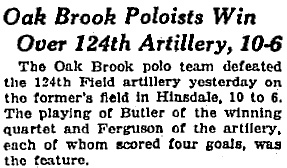
June 10, 1925

September 4, 1928

June 22, 1931
Oak Brook 4 Defeats Black Horse Troop
The Oak Brook polo team scored its second victory of the season yesterday, defeating the Black Horse Troop at the Oak Brook Polo club, 15 to 6.
The victors took an early lead when Hillman and Blair scored in the first chukker. The Black Horse Troop tied the score when Schaefer and Butler garnered goals, but a goal by Crites gave Oak Brook a 3 to 2 lead at the end of the second chukker.
July 26, 1931
TWO POLO GAMES CARDED TODAY AT OAK BROOK
The Hinsdale Hurricanes, who upset the Oak Brook Ramblers last Sunday, will meet the Oak Brook Four Horsemen in the first of two matches which will be played at the Oak Brook Polo club this afternoon.
Barney Balding and Paul Butler will lead the Black Horse Troop against the Fort Sheridan Onwentsia in the second contest on field no. 3.
August 23, 1931
FIVE CHICAGOANS DECORATED AT SHERIDAN CAMP
Five Chicagoans were among the 40 citizen-soldiers at the citizens’ military training camp at Fort Sheridan yesterday before a record “Visitor’s day” crowd of 7,500 persons who turned out to witness drill exhibitions, sham battles and the final review of the 1,780 members of the organization by Col. Edward Davis. The medals were presented by Paul Butler, Illinois civilian aid to the Secretary of War, and Dr. George James, national executive secretary of the Military Training Camps association.
May 30, 1932
GRATEFUL CITY TODAY HONORS ITS HERO DEAD
Plan First Parade in Two Years.
Black Horse Troop to Parade.
Far up in the line of march will come the Black Horse Troop under the command of Capt. Paul Butler as escort to the reviewing officers, including Lieut. Gov. Sterling and the governor’s staff, United States Senator Lewis, Mayor Cermak and others.
June 17, 1932:
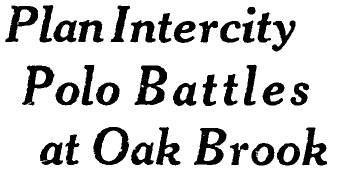
The plans being made by the Oak Brook Polo club to bring leading polo teams form Detroit, Cleveland, Toledo, Cincinnati, and Kansas City to Chicago for matches will make the city one of the polo centers of the country this summer.
November 11, 1932
Oak Park Oak Leaves
Opening New Home of Chicago Historical Society on Saturday
Official public opening of the new building of the Chicago Historical society will take place Saturday noon. Participating with President Charles B. Pike and trustees will be leaders of civic and educational organizations. The Black Horse Troop, Capt. Paul Butler commanding, will form a guard of honor. The official ceremonies will take place at the east entrance of the society’s building, which faces the St. Gauden Statue of Lincoln in Lincoln Park.
December 7, 1933
Oak Park Oak Leaves
Black Horse Polo Teams to Play at The Riding Club
Chicago Black Horse polo teams will play at 8:15 Saturday night at the Riding club, 333 East Erie. …
The Chicago Black Horse troop is commanded by Captain Paul Butler, formerly of Oak Park and now of Hinsdale, and a number of western suburbanites are numbered in the membership of the troop. The Chicago Black Horse Troop band, led by A. Boyd Pixley, will play during the intermission and rest periods. This famous band is one of the very few mounted bands in the country and was mustered into service and federally accepted as the regimental band of the 106th Regiment of Cavalry on July 12, 1929. It is attached to the troop and under the command of Captain Paul Butler.
May 31, 1934:
THRONGS CHEER GREAT PARADE OF WAR HEROES
City Pays Tribute Both to Living and Dead.
In a great parade down Michigan avenue, in special services at the city's cemeteries, and in the hearts of its citizens, Chicago observed Memorial day yesterday and paid tribute to its war heroes, living and dead.
Crowds See Chicago Parade.
Chicago's main interest was in the Michigan avenue parade. Hours before the first unit began marching from Chicago avenue the sidewalks were lined as far south as the Logan monument in Grant park.
It was regarded as Chicago's greates Memorial day parade. For two hours and a half the gayly uniformed units streamed past the reviewing stand.
Leading the line of the march were six platoons of mounted police of the Chicago force.
Black Horse Troop in Line.
Behind them came the Black Horse Troop of the Illinois National Guard, with its mounted band. At the head was Capt. Paul Butler, leading the ranks of coal black horses, with the men resplendent in smart uniforms of black and white, topped by dragoon helmets.
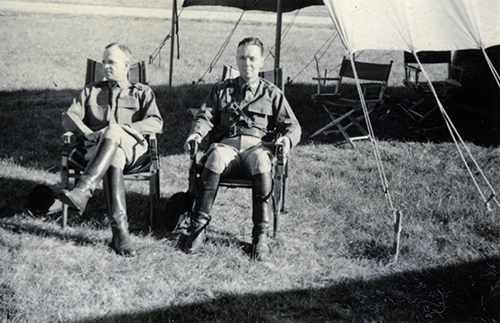
Courtesy of the Butler Family Archive.
Above: Capt. Paul Butler seated on the right, alongside an unkown fellow cavalry officer.
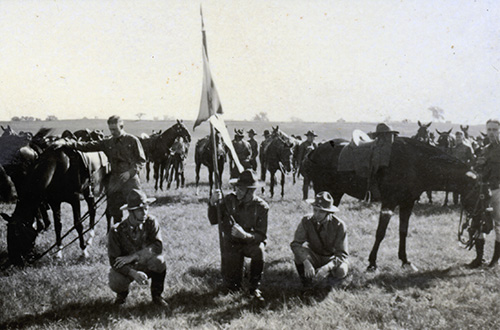
Courtesy of the Butler Family Archive.
Above: Capt. Paul Butler, left, kneeling alongside unknown 106th Cavalry officers.
|
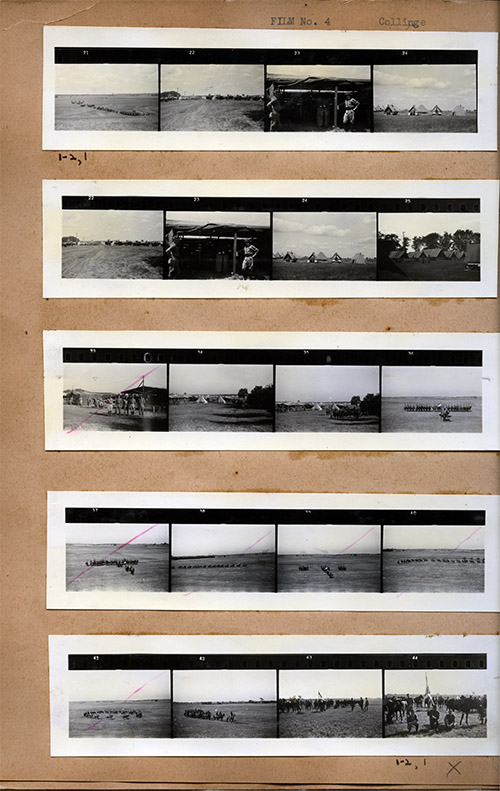
Contact sheet of Paul Butler's 35mm negatives of the
106th Cavalry from 1933, presented courtesy of the Butler Family Archive.
November 25, 1931
 Capt. Chauncey McCormick commander of the Black Horse troop has resigned the command, it was learned yesterday. First Lieutenant Paul Butler, next in succession, is acting as troop commander. Capt. McCormick headed the troop for the last time at the regular drill meeting Monday night.
Chauncey McCormick, who had agreed to command the Troop from its inception two years prior, left because of buisiness pressures.
Capt. Chauncey McCormick commander of the Black Horse troop has resigned the command, it was learned yesterday. First Lieutenant Paul Butler, next in succession, is acting as troop commander. Capt. McCormick headed the troop for the last time at the regular drill meeting Monday night.
Chauncey McCormick, who had agreed to command the Troop from its inception two years prior, left because of buisiness pressures.
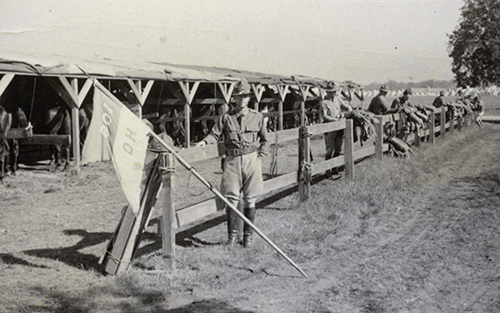 Courtesy of the Butler Family Archive.
Above: Capt. Paul Butler standing with the flag for the 106th Cavalry Headquarters Troop, also known as the ceremonial Black Horse Troop.
After Paul Butler's command of the Troop ended in the mid-1930s, he remained active in the horse and polo community and at the Chicago Avenue Armory:
October 3, 1947:
Horse Show Opening
Courtesy of the Butler Family Archive.
Above: Capt. Paul Butler standing with the flag for the 106th Cavalry Headquarters Troop, also known as the ceremonial Black Horse Troop.
After Paul Butler's command of the Troop ended in the mid-1930s, he remained active in the horse and polo community and at the Chicago Avenue Armory:
October 3, 1947:
Horse Show Opening
The opening of the fourth annual Chicago Horse show tonight in the Chicago Avenue Armory at 234 E. Chicago av. will be the occasion for a round of gala dinner parties beforehand, one of the largest of which will be given by John F. Cuneo, chairman of the show, in the Camelia House. Gov. and Mrs. Green will be among his guests, as will August A. Busch of St. Louis.
Among others who will entertain at the Camelia House tonight before the show will be Paul Butler, president of the Chicago Horse Show association, and Mrs. Butler.
When the 106th Cavalry regiment was mechanized in 1942 for service in the Second World War, the Black Horse Troop disbanded. It never recovered its status as a ceremonial unit.
After WWII, former Black Horse Troop members formed an American Legion post and in ten years the Troop, diminished for lack of membership, disolved. In the mid-1980s, another incarnation of the Black Horse Troop Association appeared in the Chicago area and appeared in suburban parades.
The Chicago History Museum maintains the Black Horse Troop's archive as part of its manuscript collection:
Chicago Black Horse Troop Association. Chicago Blace Horse Troop Association records, 1929-1955.
Charter (1929 June 27), constitution and by-laws, minutes of annual and special meetings of directors and members, financial records, etc. in leather-bound volume and records of the association that did fund-raising and supported the Chicago Black Horse Troop and Mounted Band also known originally as the Headquarters Troop and Band of the 106th Cavalry, Illinois National Guard, 33rd Division. The Black Horse Troop performed in many parades and military shows.
From within the museum's collection I learned that
the newly formed Chicago Black Horse Troop Association had passed a resolution to recognize Paul Butler's son and grandson as honorary members of the Troop.
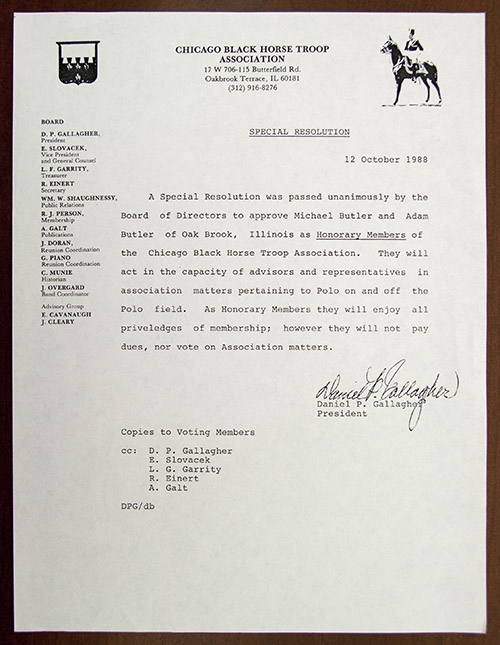 Courtesy of the Chicago History Museum. Courtesy of the Chicago History Museum. |



 Courtesy of the Chicago History Museum.
Courtesy of the Chicago History Museum. 




